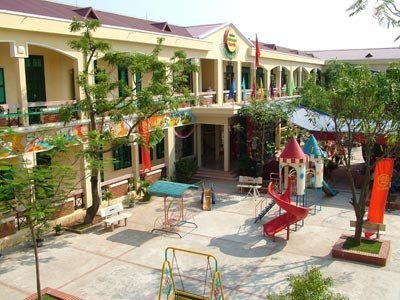VietNamNet Bridge – The limited land fund and the low budget have been cited as
the main reasons that have hindered the construction of schools meeting national
standards in the inner Hanoi city.

Problems arising everywhere
Under the plan on building standardized schools drawn up by the Hanoi Education
and Training Department, in the period from 2012 to 2015, the city would need to
have 660 more standardized schools. Meanwhile, in 2015 alone, the city would
have to build 128 schools.
The representatives who attended the conference on reviewing the development of
national standardized schools held in early July, all expressed their worry that
the plan on building standardized schools may be unattainable.
Thanh Tri district is considered the district with the highest percentage of
schools meeting national standards (52.5 percent). However, the school
development in the locality is also facing barriers because of the regulations
on the Dykes Law.
A leader of the district said six schools in the communes of Duyen Ha, Van Phuc
and Yen My all can meet the standards in terms of teaching and learning
conditions, but they may not be recognized as standardized schools.
The Ministry of Education and Training has lowered the requirements on
standardized schools recently in an effort to speed up the process of
standardized school development.
The standardized schools in the inner city, where every inch of land can be used
for commercial purpose, do not compulsorily have the floor area of less than 6
square meters per student.
However, the new regulation has not helped much in speeding up the process.
While inner city areas do not have enough land to build schools, suburb areas,
though having land, do not have money to build schools.
Ba Dinh and Hai Ba Trung districts both have the percentage of standardized
schools at less than 20 percent. Phu Xuyen district in the suburbs is also a
locality with the low percentage of standardized schools, while it needs 700
billion dong more to build 45 more standardized schools.
Tran Cong Thanh, Head of the Education Sub-department in Phu Xuyen district,
said the locality budgets over 50 billion dong a year to the construction of
schools. However, the budget is just big enough to improve the degrading
schools.
Nursery schools ignored?
The average proportion of standardized schools in Hanoi is 28 percent. However,
the proportions are quite different for different education levels.
While 46.5 percent of primary schools have met the standards, the proportions
are lower at 31.5 percent for secondary schools and 14.4 percent for nursery
schools.
Dan Phuong, Thanh Tri, Long Bien, Gia Lam and Ha Dong are the districts which
have the highest percentage of standardized nursery schools (over 40 percent).
Meanwhile, the figures are very low in Phu Xuyen, Thuong Tin, Quoc Oai and Ba
Vi, about 3 percent.
One of the main reasons behind the low number of standardized schools is the
lack of investments. Though striving to have 55 percent of its schools meeting
standards by the end of 2012, Gia Lam district authorities have admitted that
they now can only focus on primary and secondary schools. Meanwhile, only four
nursery schools out of the 24 existing schools in the locality can meet
standards (16 percent).
Source: Ha Noi Moi
- © Copyright of Vietnamnet Global.
- Tel: 024 3772 7988 Fax: (024) 37722734
- Email: evnn@vietnamnet.vn